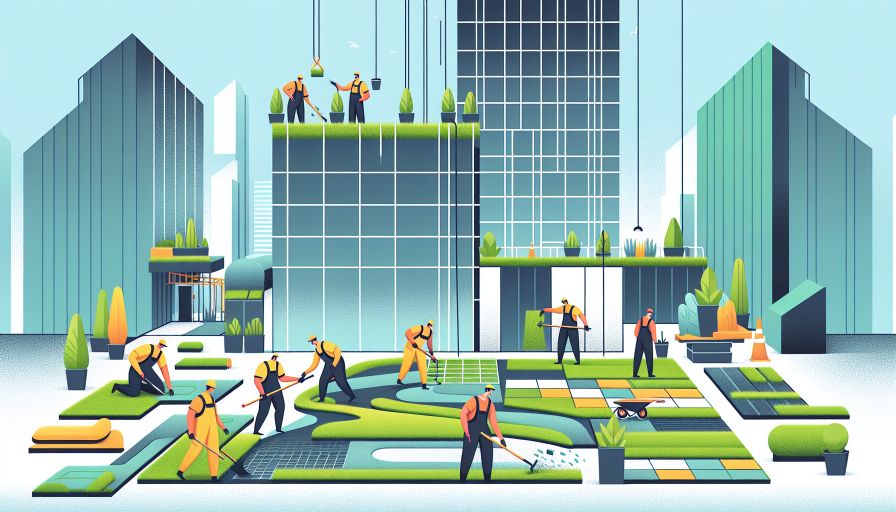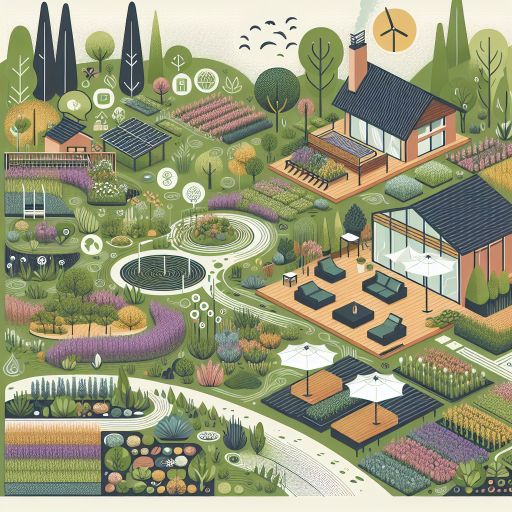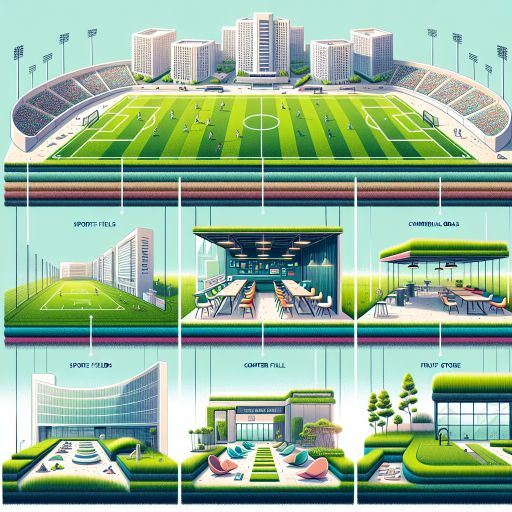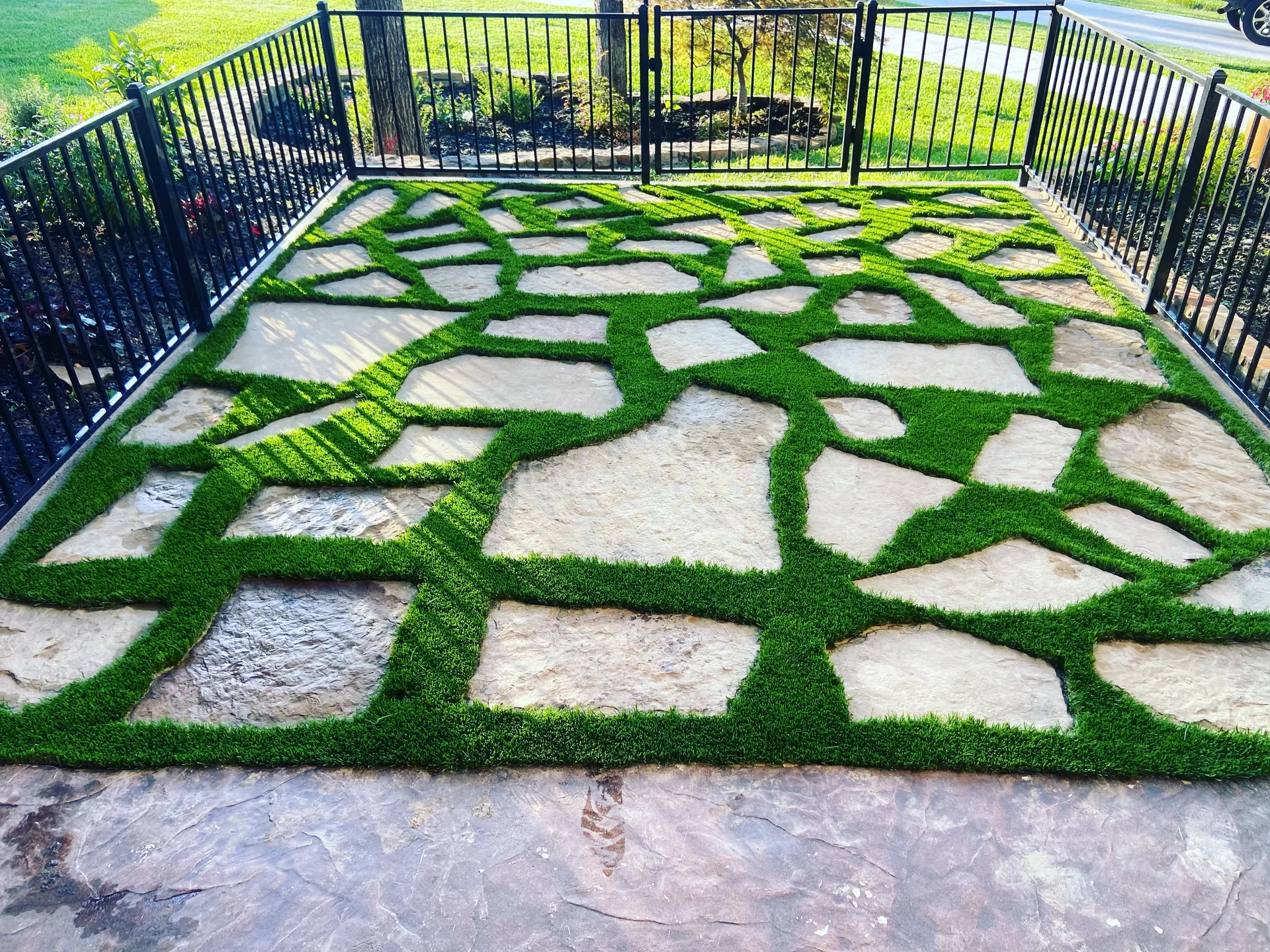
- Introduction to Innovative Landscaping
- The Evolution of Artificial Turf: From Sports Fields to Commercial Spaces
- Technological Advancements in Artificial Turf Design and Installation
- Environmental and Economic Benefits of Custom Artificial Turf
- Case Studies: Successful Transformations of Commercial Spaces
- The Future of Artificial Turf in Commercial Landscaping
Introduction to Innovative Landscaping
At Prime Design Turf, we have dedicated over 20 years to redefining outdoor aesthetics through the use of top-quality synthetic turf. Our work stretches across various domains, from enhancing residential gardens to creating safe, engaging playgrounds and manicured sports fields. What sets us apart is not just our extensive experience but also our unwavering commitment to providing creative, personalized designs and meticulous installations.
Prime Design Turf stands as the DFW area’s premier turf company, offering a plethora of services to meet diverse landscaping needs. We pride ourselves on transforming spaces into visually stunning and functional areas that cater to specific requirements. Whether it’s installing a backyard putting green, developing a pet-friendly zone free of toxic substances, or revolutionizing parks and playgrounds, our approach is grounded in a deep understanding of our client’s needs paired with our industry-leading expertise.
Our innovative approach to landscaping is driven by an ethos of quality and excellence. The synthetic turf solutions we provide are designed to be durable, eco-friendly, and cost-effective. By combining state-of-the-art technologies with creative design strategies, we ensure that every project not only meets but exceeds expectations.
Our dedication to personal service means that we work closely with our clients throughout the entire process, from initial consultation to final installation. This hands-on approach allows us to tailor each project to the specific needs and preferences of our clients, ensuring a bespoke solution that enhances the beauty and functionality of any commercial space.
At Prime Design Turf, transforming commercial spaces with custom artificial turf designs isn’t just about aesthetics; it’s about adding value, sustainability, and practicality. Our strong focus on quality, creativity, and customer satisfaction sets us apart as leaders in the field of innovative landscaping.
The Evolution of Artificial Turf: From Sports Fields to Commercial Spaces
The use of artificial turf has significantly evolved since its inception, undergoing substantial changes that have expanded its applications beyond sports fields to various commercial spaces. Initially developed in the 1960s, artificial turf became widely recognized through its use in Major League Baseball stadiums like the Houston Astrodome. Over the decades, advancements in materials and manufacturing processes have made artificial turf a versatile and appealing option for many commercial landscapes.
Early Developments
Artificial turf, originally known as “Chemgrass,” was first introduced by Monsanto in the mid-1960s. Its early iterations were designed primarily for sports fields, aiming to offer a durable, weather-resistant alternative to natural grass. The first major installation at the Houston Astrodome in 1966 marked a significant milestone, showcasing artificial turf’s potential in high-traffic environments.
Material Innovations
Throughout the 1970s and 1980s, artificial turf underwent several material improvements. The initial nylon-based fibers were gradually replaced by more advanced polypropylene and polyethylene materials that offered enhanced softness and durability. These new materials reduced the abrasiveness of early artificial turf, making it more suitable for a broader range of applications.
Expansion to Commercial Spaces
By the 1990s, the benefits of artificial turf—lower maintenance, water conservation, and long-term cost savings—began to attract interest from commercial property owners and landscape architects. Hotels, office complexes, and retail centers started to incorporate artificial turf into their landscape designs, leveraging it to create aesthetically pleasing and functional outdoor spaces that remained green and lush year-round without the upkeep challenges associated with natural grass.
Current Trends
In the 21st century, the use of artificial turf in commercial landscapes has continued to grow. Modern artificial turf systems utilize advanced technologies to replicate the look and feel of natural grass more closely than ever before. Today’s installations often incorporate features such as UV stabilization to prevent color fading, advanced drainage systems to manage rainwater effectively, and antimicrobial treatments to maintain hygiene in high-traffic areas.
- Commercial rooftops and terrace gardens
- Outdoor event spaces and courtyards
- Play areas and recreational zones
- Green walls and interior landscaping
The evolution of artificial turf demonstrates its transformative impact on commercial landscaping. From its origins on sports fields to its current applications across myriad commercial environments, artificial turf continues to offer practical solutions that combine durability, aesthetics, and sustainability.
Technological Advancements in Artificial Turf Design and Installation
The development of artificial turf has been greatly influenced by technological advancements, facilitating its evolution from merely a substitute for natural grass in sports fields to a versatile landscaping solution for commercial spaces. Two primary areas of technological progress include materials engineering and installation techniques.
Modern artificial turf is composed of advanced synthetic fibers that mimic the appearance and feel of natural grass. These fibers are typically made from a combination of polyethylene, polypropylene, and nylon. Polyethylene is renowned for its soft texture and vibrant color, making it a popular choice for landscaping applications. Polypropylene offers increased durability and resilience, ideal for areas with high foot traffic. Nylon, although more expensive, provides the highest level of durability and is often used in applications that require maximum wear resistance.
One significant technological advancement in materials engineering is the development of infill systems. Infill materials, such as silica sand and crumb rubber, are added to the turf to provide stability, cushioning, and support. This not only enhances comfort but also extends the lifespan of the turf. Innovations in infill technology have led to the use of alternative materials such as organic infills made from cork or coconut husks, which are more environmentally friendly.
Another key advancement is in the design of the turf’s backing. The backing is a critical component that provides structural integrity and drainage. Modern backings often incorporate multiple layers, including a primary backing made from woven polypropylene and a secondary backing that enhances strength and dimensional stability. Perforations in the backing enhance drainage, preventing water accumulation and promoting quick drying.
| Component | Description |
|---|---|
| Synthetic Fibers | Made from polyethylene, polypropylene, or nylon; designed to mimic natural grass. |
| Infill Systems | Materials like silica sand, crumb rubber, and organic alternatives used to provide stability and cushioning. |
| Backing | Multi-layered structure that provides strength, dimensional stability, and enhanced drainage. |
Installation techniques have also evolved, with modern methods focusing on efficiency and precision. One significant advancement is the use of laser grading equipment to prepare the base. This ensures a level and consistent surface, which is crucial for the proper installation and performance of the turf. Additionally, advanced seaming techniques, such as the use of seam tapes and adhesives, have improved the seamless integration of turf sections, resulting in a more natural appearance and enhanced durability.
There have also been improvements in edge treatments and securing mechanisms. Anchoring systems now often include the use of heavy-duty stakes and perimeter edging to prevent movement and ensure the turf remains securely in place. These innovations collectively contribute to the increasingly widespread adoption of artificial turf in commercial landscaping, offering an aesthetic and functional alternative to natural grass.
Environmental and Economic Benefits of Custom Artificial Turf
In recent years, custom artificial turf has gained popularity in commercial landscaping due to its numerous environmental and economic benefits. This chapter delves into these advantages, supported by real data and studies.
Environmental Benefits
One of the most significant environmental benefits associated with custom artificial turf is its ability to conserve water. According to the Environmental Protection Agency (EPA), traditional grass lawns account for nearly one-third of all residential water use, amounting to billions of gallons each year. Custom artificial turf eliminates the need for watering, leading to substantial water savings.
Another critical advantage is the reduction in chemical usage. Natural grass maintenance often requires fertilizers, pesticides, and herbicides, which can run off into waterways, causing pollution and harming aquatic ecosystems. Since artificial turf does not require these chemicals, it helps to protect water quality and nearby ecosystems.
Artificial turf also contributes to lowering the carbon footprint. Traditional lawn maintenance typically involves the use of gas-powered equipment such as mowers, trimmers, and blowers. These machines emit carbon dioxide and other pollutants. By switching to artificial turf, commercial spaces can significantly reduce their emissions, aligning with sustainability goals and regulations.
Economic Benefits
From an economic standpoint, custom artificial turf offers a range of benefits, primarily through cost savings on maintenance. Traditional lawns require regular mowing, fertilizing, reseeding, and pest control. These expenses add up over time. A report by the Synthetic Turf Council indicates that maintenance costs for artificial turf can be up to seven times lower than that of natural grass over a 15-year period.
Moreover, artificial turf provides enhanced durability and longevity. High-quality custom artificial turf is designed to withstand heavy foot traffic and harsh weather conditions, reducing the need for frequent replacement and repair. This durability translates into long-term savings for commercial property owners.
Another economic advantage is the potential increase in property value. A well-maintained, aesthetically pleasing landscape can attract tenants and customers, boosting occupancy and revenue. Custom artificial turf’s ability to maintain its appearance throughout the year ensures that commercial spaces remain visually appealing, contributing to a positive image and customer satisfaction.
Conclusion
Overall, the environmental and economic benefits of custom artificial turf make it an appealing choice for commercial landscaping. By conserving water, reducing chemical usage, lowering carbon footprints, and offering significant cost savings, artificial turf provides a sustainable and economically viable solution for transforming commercial spaces.
Case Studies: Successful Transformations of Commercial Spaces
Case Studies: Successful Transformations of Commercial Spaces
Several commercial spaces have successfully implemented custom artificial turf designs to enhance their environments, demonstrating the diverse applications and benefits of synthetic solutions. This chapter examines a selection of these cases, highlighting how custom artificial turf has transformed commercial spaces and yielded positive outcomes.
Retail Complexes
One of the most notable applications of artificial turf in retail complexes is its use in creating appealing, low-maintenance landscapes that attract customers. Many shopping centers have replaced traditional grass with artificial turf in common areas, seating zones, and even parking lots. This shift has resulted in reduced water usage, lower maintenance costs, and an aesthetically pleasing environment that remains lush and green year-round. Studies have indicated that an attractive exterior can increase foot traffic, enhancing the overall shopping experience.
Corporate Campuses
Corporate campuses often incorporate substantial green areas to provide employees with recreational spaces and aesthetic appeal. Artificial turf has been used effectively in these environments to create functional, durable outdoor spaces that require minimal upkeep. For example, several Fortune 500 companies have utilized artificial turf for rooftop gardens, courtyards, and walking paths. These installations not only foster a pleasant work environment but also align with corporate sustainability goals by conserving water and reducing landscaping chemicals.
Hospitality Industry
Hotels and resorts have increasingly adopted artificial turf to transform their outdoor areas. High-traffic zones such as poolside lounges, garden spaces, and event areas benefit significantly from the durability and visual appeal of synthetic grass. The consistent quality of artificial turf ensures these spaces always look pristine, enhancing guest satisfaction. Additionally, the cost savings from reduced water use and minimal maintenance contribute to the overall operational efficiency of these establishments.
Healthcare Facilities
Healthcare providers are also leveraging the advantages of artificial turf to create healing and therapeutic environments. Hospitals and rehabilitation centers often use synthetic grass in patient courtyards, therapy gardens, and children’s play areas. These installations provide safe, non-toxic surfaces that are easier to keep hygienic compared to natural grass. Research has shown that access to green spaces can significantly improve patient recovery times and overall well-being.
Educational Institutions
Schools and universities face unique challenges in maintaining vast outdoor areas that accommodate sports, recreation, and daily student activities. Artificial turf offers an ideal solution by providing durable, multi-use surfaces that withstand extensive use. Many institutions have redesigned their sports fields, playgrounds, and common areas with synthetic turf, resulting in fewer maintenance interruptions and more consistent usability throughout the school year. Moreover, artificial turf fields can often be used shortly after rainfall, ensuring continuous access for students.
These case studies illustrate the transformative potential of custom artificial turf designs in diverse commercial settings. By embracing innovative landscaping solutions, various industries have reaped significant environmental, economic, and aesthetic benefits, paving the way for broader adoption of artificial turf in the future.
The Future of Artificial Turf in Commercial Landscaping
As we look to the future of artificial turf in commercial landscaping, several trends and advancements promise to reshape how businesses approach their outdoor spaces. Innovations in materials science, growing environmental awareness, and evolving aesthetic preferences are key drivers steering the direction of artificial turf usage.
One significant trend is the development of biodegradable and recyclable artificial turf materials. Manufacturers are increasingly focusing on creating products that can be broken down and reused at the end of their lifecycle, addressing a long-standing concern about the environmental impact of synthetic turf disposal. Companies such as TenCate Grass are pioneering recyclable turf systems that reduce the environmental footprint of artificial landscapes.
Another promising advancement is the improvement in heat resistance and cooling technologies. Traditional artificial turf can become hot under direct sunlight, making it uncomfortable for usage. However, new products incorporating cooling technology, such as CoolPlay systems, use advanced infill materials to keep surface temperatures lower. This innovation extends the usability of turf in warmer climates and enhances comfort for anyone interacting with the space.
In terms of aesthetics, developments in fiber technology and coloring techniques have made artificial turf virtually indistinguishable from natural grass. Manufacturers are producing turf with varied blade shapes, lengths, and color gradients to mimic the appearance of real grass more convincingly. This realism is crucial for businesses aiming to maintain a natural look while enjoying the low maintenance benefits of synthetic turf.
Moreover, the integration of smart technologies into artificial turf systems is an emerging trend. Sensors can be embedded in the turf to monitor foot traffic, moisture levels, and other environmental conditions. This data can help property managers optimize maintenance schedules and ensure that the turf remains in peak condition year-round. For instance, companies like Synlawn are exploring the use of such technologies to enhance user experience and turf longevity.
On a broader level, the adoption of artificial turf is part of a larger movement towards sustainable and efficient building practices. Certification programs, such as LEED (Leadership in Energy and Environmental Design), encourage the use of eco-friendly materials, including artificial turf, in commercial landscapes. By selecting high-quality, sustainable turf options, businesses can contribute to their environmental credentials and appeal to eco-conscious consumers and partners.
Looking forward, the role of artificial turf in commercial landscaping will likely continue to expand. Enhanced product offerings, combined with technological innovations and sustainability trends, position artificial turf as a versatile and attractive option for businesses looking to create inviting, low-maintenance outdoor spaces. The emphasis will remain on developing products that balance aesthetic appeal, functionality, and environmental responsibility, ensuring that artificial turf remains a viable and popular choice in the commercial landscape sector.


